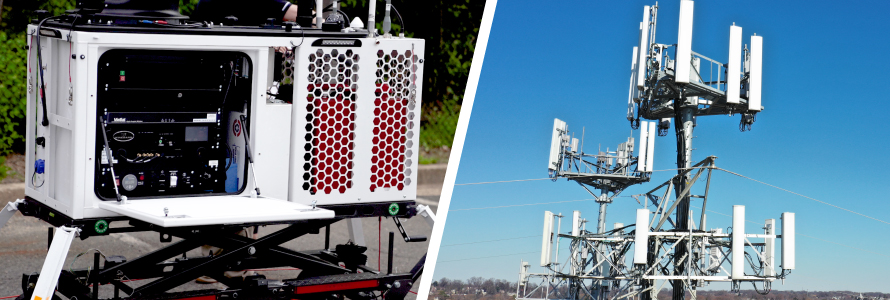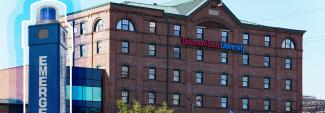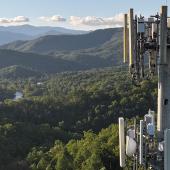This blog is a repost from MissionCritical Communications magazine, originally published in Spring 2022.
Emergencies know no boundaries, a reality that first responders live every day. They can be called to duty in incredibly hard-to-reach locations from mudslides in Glenwood Canyon in Colorado and tsunami threats on a remote peninsula home to the Makah Tribe to a COVID field hospital inside a million square-foot convention space.
That’s why coverage is king for public-safety communications. First responders need connectivity in the places where their mission takes them.
At the First Responder Network Authority (FirstNet Authority), we ensure that public safety’s critical communications needs are at the center of the deployment of FirstNet, the nationwide public-safety broadband network. Together with our network contractor, AT&T, we’ve engaged with public safety officials to map out expanding network coverage, including in traditionally underserved and rural areas. We are also driving innovation in new, flexible coverage solutions that first responders can use whenever and wherever they’re called. And we are evolving the network with access to 5G. This is a public-safety-first approach that is truly unique to FirstNet.
Building Expansive Infrastructure
In the yesteryear of public safety communications, technology was a mixed bag of LMR networks, siloed among agencies and jurisdictions, each operating to its own set of standards. The options for data exchange were limited to a few narrow bands of authorized spectrum.
After the tragedies of 9/11, police, fire, and EMS leaders from across the country came together to advocate before Congress for an interoperable nationwide, high-speed broadband network. In 2012, a law was enacted authorizing $7 billion and 20 megahertz of broadband spectrum to establish a network for first responders. The law also created our organization, the FirstNet Authority, to oversee the deployment of the network.
In February we marked the 10th anniversary of that public-safety milestone. Even before the legislation was passed, public-safety leaders underscored the need for a public-safety network that would be available when and where first responders need it most. That’s why we made coverage, especially for rural and remote areas, a top priority in our planning efforts and in our contract with AT&T to build, deploy, and maintain the network.
In the five years since launching our FirstNet public-private partnership, network coverage has grown substantially. Today, AT&T has said the network buildout of Band 14 — the high-quality spectrum dedicated to first responders — has surpassed 95% completion under the contract. According to AT&T, about 100,000 square miles were added to the FirstNet network in 2020, reaching 99% of Americans.
Coverage for Remote, Rural Areas
First responders in rural areas have particularly seen improvements in connectivity with FirstNet.
Just take responders in Washington County, Maine, the state’s third least populous county. They are responsible for serving 33,000 residents across an area larger than Delaware and Rhode Island combined. With dense forests and rugged coastlines, local responders have long struggled with poor coverage. But with the FirstNet buildout, first responders in Washington County are benefiting from enhanced coverage where they told us they needed it most.
“Switching over to FirstNet, it was like night and day,” said County Manager Betsy Fitzgerald. “Previously, if you were on the phone, you couldn't go to certain parts of the county because it would drop the call. Now, we can travel from point A to point B and the FirstNet phone manages to maintain its connectivity. We are able to talk when it really makes a difference.”
As part of FirstNet’s buildout plans, we worked with public-safety leaders in all 50 states, five territories, and the District of Columbia to identify areas of coverage. This led to expanding coverage with new site builds at strategic locations that have been prioritized by local public-safety officials. These new cell sites integrate Band 14 to ensure a more reliable connection for local responders.
A New Approach to Coverage
In addition to traditional terrestrial coverage, we heard public safety’s need for innovative and agile coverage solutions for harder-to-reach areas or following disasters to support response, recovery, and restoration efforts. One way we have followed through on this promise is through FirstNet dedicated deployables, which can be requested by subscribing agencies — at no additional cost — to boost coverage when cellular infrastructure is limited or damaged, or more capacity is needed. Located at sites throughout the country, the fleet of FirstNet deployables includes ground-based satellite cell on light trucks (SatCOLTs), communications vehicles, tethered drones, and a blimp. To meet the increasing demand for deployables, the FirstNet Authority authorized one of its first network investments in expanding the deployable fleet. Today, the fleet boasts more than 100 assets.
Feedback from public safety also showed that first responders are looking for options they can deploy themselves. That’s why we’re advancing unique solutions that go beyond network infrastructure and conventional deployables.
Compact Rapid Deployables
A unique FirstNet coverage solution comes in the form of compact rapid deployables (CRDs). This new technology is a smaller mobile cell site unit that can be customer-owned and activated by a single person within a matter of minutes.
Because of their versatility, CRDs provide FirstNet cellular and Wi-Fi coverage virtually anytime and anywhere. The units are small enough to fit through doorways and can be transported using a regular trailer hitch or flown into a remote location on a helicopter.
CRDs are built to withstand the elements: They’re weatherproof and operate in temperatures from -22° to 122° Fahrenheit. The typical range for cellular coverage is half a mile and, and Wi-Fi is up to a thousand feet. And because they can last up to 60 hours before needing to be refueled, they are valuable assets for first responders battling natural disasters in difficult terrain.
Weather was a major factor in the December 2021 Marshall Fire, the most destructive in Colorado’s history, as it swept through densely populated neighborhoods in Boulder County. High winds, at speeds equivalent to a Category 2 hurricane, fueled the fire and felled infrastructure. And then a snowstorm hit.
Mud, snow, and low-hanging power cables made it dangerous and difficult to transport a large SatCOLT to the top of a steep, curvy mountain. Instead, the team on the ground used a CRD to quickly set up coverage. With the help of a standard pickup truck, they were able to transport the unit over the difficult terrain. It was in place and operational in less than an hour from when the CRD arrived on site, keeping first responders connected until the SatCOLT could be set up.
The Washington Military Department also purchased CRDs to provide connectivity during wildfires.
“It’s been a challenge for us to stay connected to our emergency response teams across the state during the last few fire seasons,” said Mark Glenn, chief information officer and IT director for the department. “The coverage that FirstNet and the CRD device will provide will allow us to be flexible during our response to disasters and bring coverage to first responders onsite at the scene.”
Maximizing FirstNet Coverage with HPUE
FirstNet MegaRange, also called high power user equipment (HPUE), is transforming the way we approach access to coverage at the edge of a cell site. These technologies in FirstNet’s growing ecosystem of devices boost signal strength up to six times the normal cellular power to maximize the network’s coverage. FirstNet’s Band 14 spectrum is the only band in the United States licensed for HPUE.
In urban environments, MegaRange can help improve connectivity in hard-to-reach spots like parking garages and basements. In remote, rural and maritime environments, connectivity is improved at the edge of the network’s typical signal coverage.
FirstNet MegaRange is designed to improve connectivity and throughput to FirstNet towers. Following Third Generation Partnership Project (3GPP) standards, HPUE transmits stronger signals using FirstNet’s Band 14 spectrum and specially designed FirstNet modems. The increased signal provides a more reliable coverage area, improving uplink data speeds at the edge of the network.
Public-safety officials in Texas have successfully extended the range of the network using HPUE and experienced the benefits that follow.
“With FirstNet MegaRange, we noticed a substantial coverage improvement in some remote areas, and we sustained high data speeds even as we moved further away from wireless towers,” said Jared Vandenheuvel, program coordinator with the Texas Department of Public Safety. “This will be especially advantageous for public safety and first responders who have high uplink needs, such as drone teams sending video back to operations centers.”
Opening Possibilities with Initial 5G
HPUE and CRDs bring FirstNet coverage into the nooks and crannies not covered by fixed cell infrastructure. These unique coverage solutions are helping first responders adapt to their ever-changing operational environments.
At the FirstNet Authority, we continue to work with AT&T to drive progress in coverage buildout and to explore new solutions that fit public safety’s needs. We are also looking at ways to enhance existing coverage by enabling FirstNet subscribers to have access to AT&T’s 5G network.
In April 2021, the FirstNet Authority Board directed investments to upgrade the FirstNet Core to enable 5G for FirstNet. Subscribers now have access to AT&T’s mmWave (5G+) spectrum in parts of 44 cities and more than 30 venues, and they have access to AT&T’s 5G Sub-6 spectrum in 10 cities across the country. More access to 5G will be added as AT&T continues to deploy additional 5G spectrum across the country.
Access to 5G is a major development for FirstNet, which will help first responders take advantage of the benefits of this new technology as they are realized, including peak data speeds, higher throughput capability and improved latency. Through a greater use of 4K video, artificial intelligence (AI), more accurate location data, and an ecosystem of connected sensors, 5G is revolutionizing public-safety communications.
We are only at the beginning of future innovations for first responders. Unlike past technology upgrades when public-safety users were mostly an afterthought, they are now a critical market to consider in technology rollouts. The future holds great promise for public-safety communications. There is more work to be done to drive the delivery and implementation of mission-critical standards for 5G, and the FirstNet Authority will continue to be a voice for public safety within standards bodies.
In championing the need for FirstNet many years ago, public safety envisioned a network that would deliver fast and reliable communications to first responders wherever they needed it most. Ten years later, the FirstNet Authority has made significant progress delivering on public safety’s vision and will continue to work with the community to advance coverage and meet their critical communication needs.




















